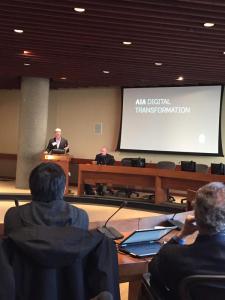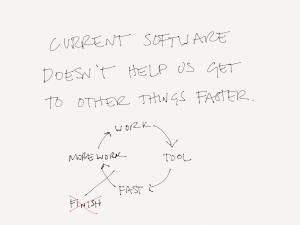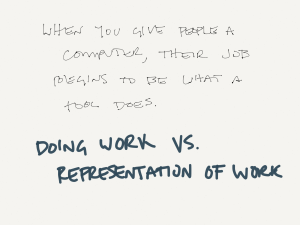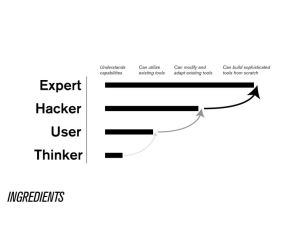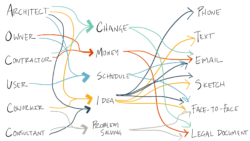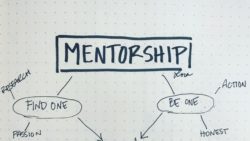Architects Making Tools: the value of why
Back in the beginning of December, I was contacted by someone at American Institute of Architects (AIA) National asking if I would like to participate in the (then) upcoming Technology in Architecture Practice (TAP) Congress. I spoke with her on the phone to learn more about the event. It is an invitation-based gathering to discuss a specific aspect of technology as it relates to the practice of architecture. It brings together 50-80 people, globally active in some facet of the subject, to discuss the issue at hand and talk about new ideas to continue moving the profession forward. I know that sounds vague and very high-brow. I promise it wasn’t. Keep reading…
I have been a part of the TAP knowledge community (if you don’t know about AIA knowledge communities, go here and check them out) since joining the AIA last year, but always on the periphery. I felt so new to everything, I was just trying to take it in and learn the ropes. Needless to say, I was surprised by the email asking me to join them in DC. I was concerned about having something to offer on the subject, but much like my first AIA Convention, I went ready to learn as much as I could on the subject.
My biggest takeaway from the whole thing was the caliber of people attending. Directors of Technology, Research and Development, or general hack-masters at medium to large-size firms. Names from software companies, Federal Employees, Nonprofit Directors, App makers, etc. The intelligence of the brains in the room was almost palpable. I was immediately grateful at being given the chance to sit in.
The specific subject for this year’s congress was “Architects Making Tools”. The structure was such that each discussion leader for a specific idea revolving around the general theme spoke for an allotted time (20-30 minutes) and then we were given discussion time immediately after for questions, follow-up comments, or ideas. Robert Ivy, AIA National Executive Director, and Elizabeth Chu Richter, 2015 AIA National President, started us off, talking about the re-positioning of the AIA as a whole and how proper and well-created tools can continue to tell the story of Architecture and promote the value of Architects.
Throughout the day, many spoke on the importance of open source data and sharing tools to continue to move the profession forward. The discussion of the importance of creating a new tool for our use, versus when the client can inherently understand and appreciate the tool was brought up, too. It was questioned as to whether we can describe the fine line where technology is merely helpful versus transforming. Many brought up the idea that the technology, the apps, the hacking of both…which is supposed to save us time…doesn’t typically end up saving time from projects, but instead makes them more complex.
As we try to re-tell the story of our importance as a profession, I think it’s important to focus on what WE do. Not what the tool does. As Greg Schleusner from HOK mentioned, it still requires a human to create the beginnings of the computation. But when you give a person a tool, the factory setting has taught us that their job becomes about what that tool does, not what they as a human can do. Are we stifling our value by simply telling our story via these tools?
Zigmund Rubel from Aditazz spoke more to the creativity and the storytelling of architecture. The tools are well and good and allow us to perform the mundane tasks faster, but we need to realize that “the beauty of architecture is still for the human.”
A running undercurrent through most of the talks was the place for technology in the firm. The learning, research, and training must be integral to a firm to keep moving forward. Granted, many of those who spoke were from firms large enough to fund a Research and Development department via Overhead costs, but the point is that they’re making it a priority. Andrew Heumann from NBBJ showed the following two slides about the levels of tech users and the positions they held in firms:
When I saw this, the idea of scale-ability of technology clicked. Throughout the day, I listened in amazement at all of the cool and wonderful things others in the profession are using technology to achieve. All the while thinking that there’s no way most firms can pull those things off. These two images broke through that wall for me. In a large firm, the image on the right of firm titles to tech user is (or should be) correct. Andrew’s point was that firm leadership may not need to integrally know how to operate the software, but they need to know how it works to know how future problems might be solved. As you get closer to the project, your technology understanding should go up. What clicked for me related to scale was moderately similar: Depending on your desire to work in an in-depth way with technology, a sole practitioner should most definitely be the thinker, probably a user, and maybe .1% of their time is spent hacking, making the tools work best for them and their desired output. As you add people to the staff count, the users and hackers increase and you might have an expert on board by 10 people (again, depending on firm goals).
This brings me to my next, and ultimate, learning point. I’ve been reading a number of business books lately about setting yourself up for success, setting yourself apart, cultivating creativity, etc. I also read a lot of articles about these same ideas and the day to day operations of healthy/unhealthy businesses. What I’ve learned along the way is that these issues on a macro level, and the values of a project at a micro scale, are enveloped in firm culture. If the firm doesn’t instill something as a value, if they don’t prioritize it, there’s no way it’s going to show up in a project. Roderick Bates from Kieran Timberlake said just that: When you’re trying to solve a problem, you have to understand it. To understand it, you have to start with why. The WHY is your firm culture.
You can make a tool just a tool. You can do the same thing you used to do with ink and vellum in 2D software all the way up to BIM. But you might be transferring bad habits and you definitely aren’t using the tool to its full potential. The question is WHY do you want to use the tool? How are you using it to tell your story and provide your client with a knock-out project? There is no silver bullet in solving architectural projects, and because of the variety of work we do, our knowledge base is just as diverse. But if we know our values, if we have a good grasp on our WHY, we’re bound to do a pretty spectacular job creating the right design to serve our client and the community as a whole. And that’s how we tell our value.
I am beyond grateful for the chance to sit in a room at AIA National headquarters and listen in as some of the futures of the architecture profession talked around me about their passion of technology and how their firms have been using it to create better designs for their clients and end-users. I am thankful to those who invited me to dinner after a long day of talking, only to talk some more at a casual level about work and tech integration and life in general. These are the moments I try my best to become a sponge and soak up as much wisdom as others are willing to share. These are the moments I get re-invigorated about the architecture profession as a whole. Where I specifically refocus on targeting to achieve the goals I have set for myself.
I hope this recap has done the same for you.
How do you tell your value to the world? How do you instill values in your firm? Leave a comment below. I’d love to hear from you.
I took some notes during the discussions: some thoughts, some quotes, and some doodles. To view the entire PDF of my notes, go here:

